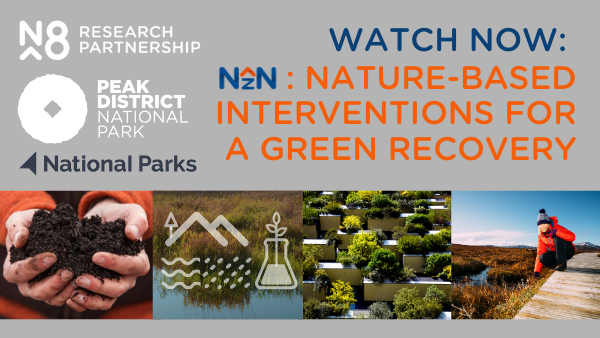
Looking ahead to the N8 Research Partnership and National Parks Net Zero North webinar which took place on 4th November, Jessica Davies, Professor of Sustainability at Lancaster University and her colleagues Victoria Janes-Bassett and Dmitry Yumashev took a closer look at the valuable role that nature based solutions can play in achieving climate solutions.
Nature has been in the news recently with Defra’s UK biodiversity indicators report showing long-term decline in many of our ecological health indicators and Sir David Attenborough’s Extinction documentary highlighting the devastating impact the human species has had on nature. Characteristic of Attenborough’s approach, the documentary ends, however, on a note of cautious positivity with a personal appeal for us to work with nature. But how do we work with nature? This is a question that has been asked by many researchers, policy makers and businesses, giving rise to the growing field of ‘nature-based solutions’ to climate and other environmental challenges.
What are nature-based solutions?
Nature-based solutions recognise that our economies and societies are underpinned by nature – without thriving ecosystems, civilisations cannot survive in the long-term. Nature–based solutions then are actions that protect, sustainably manage, restore or enhance ecosystems – be they in natural, agricultural or urban environments – such that they help simultaneously support human well-being and ecosystem health.
When it comes to climate change mitigation, nature-based solutions include conservation measures that ensure we do not lose any more land-based carbon to the atmosphere from deforestation, for example, or net-negative emission options where we attempt to capture more carbon in our ecosystems. The most prominent land-based nature-based solutions for negative emissions are afforestation, biomass for energy with carbon capture and storage (BECCS) and soil carbon sequestration.
Agriculture and soils are an important forum for nature-based climate solutions. With agriculture currently accounting for ~23% of annual human GHG emissions, finding ways to reduce and reverse these emissions in agricultural settings is important. Soils are the largest store of organic carbon in the earth system – larger than the atmosphere and the biosphere combined, and our current agricultural land management practices often result in loss of soil carbon. The potential is there to change practice and reverse trends of carbon loss, which has been recognised through initiatives such as the 4 per mil initiative that arose from the UNFCCC COP21 in Paris.
Why is interest in nature-based climate solutions growing?
Nature-based climate solutions have received much attention from the academic community* and some estimates suggest these options, if widely adopted and maintained, could provide approximately 30% of the near-term CO2 mitigation needed to keep global warming below 2°C**. In addition, we’re continuing to learn about the potential of new nature-based options such as enhanced rock weathering.
While nature-based solutions cannot be a silver bullet for climate mitigation – our GHG emissions must be reduced rapidly to prevent the worst effects of climate change – they are an important component of necessary climate action. As the IPCC Climate Change and Land Report in 2019 highlighted, all scenarios that limit climate change to 1.5°C rely heavily on nature-based solutions on land, in addition to deep decarbonisation across the whole economy, and the costs to ecosystems and risks to society of more than 1.5°C of warming are substantial.
Also, beyond just climate mitigation, nature-based solutions are an attractive proposition as working with nature offers a suite of co-benefits, both for people and nature. Investment in soil health, for example, also delivers crop productivity, water storage and quality regulation, biodiversity, and livelihood benefits.
Nature-based solutions and research in the North
There is a lot yet to learn about how to implement these solutions to best effect: how do we rigorously account for land-based carbon sequestration and capture the value of the co-benefits? How do we work with farmers to overcome the initial hurdles to adopting measures? What policies and mechanisms are needed to ensure that any benefits gained from changing land use and management practices aren’t reversed in future by conversation back to carbon poor landscapes***? Some of our work in the Soil-Value project at Lancaster University focuses on understanding the scale of opportunity at a national level, and how a changing climate affects the capacity of our soils to act as a nature-based solution. Our initial findings suggest that acting sooner rather than later with nature-based solutions such as forest creation and sustainable soils management would be beneficial before we are too far down the path of worst-climate change trajectories where mitigation becomes more challenging.
Therefore, piloting these solutions is essential – and this is what Net Zero North proposes. The opportunity is there to explore the North of England as a demonstrator for nature-based solutions. The North is a microcosm for land use and industry: with many national parks and Sites of Special Scientific Interest, arable and grassland agriculture, peatlands and uplands, as well as cities and centres of industry that could be interconnected in a sustainable bioeconomy. A great place to start to learn how to work with nature.
Find out more about nature based solutions and their vital role in driving forward sustainable solutions to both climate and economic problems by watching the recording of the webinar: Nature-based interventions for a green recovery
* e.g. (Obersteiner et al., 2010; Griscom et al., 2017; Lal et al., 2018; Smith et al., 2019)
** Griscom BWet al., 2019; We need both natural and energy solutions to stabilize our climate. Glob. Change Biol. 25, 1889-1890.)
***(Schmitz et al., 2014; Smith et al., 2016a).
